The forecasts for the domestic economy are underpinned by several technical assumptions. The exchange rate is assumed to remain around levels at the time the forecasts were prepared (a trade-weighted index of around 68 and a $US exchange rate of around 85c). Interest rates are assumed to rise slightly in line with market expectations over the forecast period. World oil prices (Tapis) are assumed to remain at around $US80 per barrel. The farm sector forecasts are based on average seasonal conditions over the remainder of the forecasting period.
Household consumption
The outlook for household consumption in the near term has weakened slightly since Budget. Consumer sentiment has fallen in recent months on the back of higher interest rates and global uncertainty surrounding European sovereign debt. Retail sales growth was subdued in the March quarter, and business liaison has indicated that spending is expected to remain subdued until the end of the year.
The forecast for household consumption growth in 2009-10 has been revised down from 2¾ per cent at Budget to 2½ per cent, with growth remaining below trend over the next couple of quarters before a more sustained recovery takes hold.
Household consumption is expected to grow by 3 per cent in 2010-11 and 3¾ per cent in 2011-12 (Chart 1), supported by continued population growth and higher incomes associated with a strong labour market and commodity price rises.
Chart 1: Household Consumption
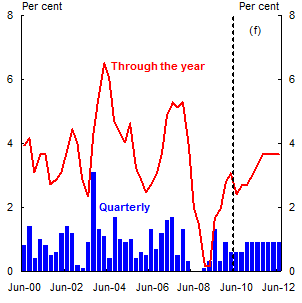
Source: ABS Catalogue Number 5206.0 and Treasury.
The acceleration in consumer spending compared with incomes sees the household saving ratio decline over most of the forecast period – but remain positive (Chart 2).
Chart 2: Household Savings Ratio
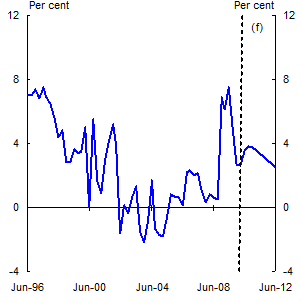
Source: ABS Catalogue Number 5206.0 and Treasury.
Dwelling investment
The expected recovery in the housing sector appears to have been delayed by longer than usual lags between obtaining finance, building approvals and construction activity. As such, dwelling investment is now forecast to grow 5½ per cent in 2010-11, compared with forecast growth of 7½ per cent at Budget.
However, the pipeline of activity still promises a rebound in residential investment as strong approvals and commencements translate into activity. Despite some monthly volatility, medium and high density approvals have recovered significantly from their low levels during early 2009 and, along with the strong pipeline for detached houses, are expected to drive activity.
While the First Home Owners Boost (FHOB) ended in 2009, its impact, in the context of the slowness in residential construction seen recently, is expected to be stretched further into 2011.
Furthermore, strong house price growth, population growth and pent up demand in the housing sector are all expected to drive construction.
As a result, dwelling investment in 2011-12 is now forecast to grow by 5½ per cent, higher than the Budget forecast of 4 per cent.
Chart 3: Private Dwelling investment (Real)
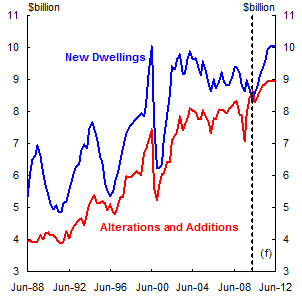
Source: ABS Catalogue Number. 5206.0 and Treasury.
Business investment
Forecasts for 2009-10 are slightly lower than Budget due to a larger than expected fall in investment in new machinery and equipment in the March quarter as the effects of stimulus related measures were unwound. However, the recovery in business investment is expected to remain on track with rising investment intentions and the expected surge in new mining investment (Chart 4). As such, new business investment is still expected to rebound in 2010-11 and 2011-12 - growing by 7½ and 12½ per cent.
In recent months, survey measures of business confidence have softened – returning to around long-run average levels more consistent with underlying economic conditions. In contrast, business survey measures of investment intentions have continued to improve. The patchiness in the survey data suggests some downside risks to the outlook for business investment.
Chart 4: Business Investment to GDP ratio (nominal)
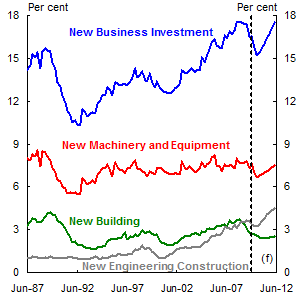
Source: ABS Catalogue Number 5206.0 and Treasury.
Forecast investment innew machinery and equipmentis broadly consistent with that expected at Budget. Investment is expected to increase by 7 per cent and 13½ per cent in 2010-11 and 2011-12 – higher than at Budget due to an increase in CAPEX intentions for 2010-11 in the latest quarterly survey.
The strength innew engineering construction investment forecast at Budget is expected to remain despite the concerns of the mining industry following the announcement of the Resource Super Profits Tax (RSPT). The expected increase in investment will be driven by major resource projects currently under construction, particularly Gorgon. Engineering investment is expected to increase by 17½ per cent in 2010-11 and 20½ per cent in 2011-12. No announcements of cancellations or suspensions to specific major projects have affected our forecasts. However, the usual uncertainty remains about the exact timing of expected spending on major resource projects.
Non-residential buildinginvestment is expected to decline by 16½ per cent and 5 per cent in 2009-10 and 2010-11. Recent investment in the sector has been strongly supported by the Building the Education Revolution program. While remaining projects will continue to provide some support in the short term, activity under the program has now peaked. Outside the education sector, building approvals remain at very depressed levels and vacancy rates do not appear to have peaked. Furthermore, access to funding remains a concern for many developers despite some easing in credit constraints. Investment is expected to rebound by 5 per cent in the last year of the forecasts as a strengthening labour market and economy stimulate activity.
Public final demand
Public final demand is forecast to grow by 9 per cent in 2009-10 and 1¾ per cent in 2010-11, before declining by 1¾ per cent in 2011-12 – driven by Government stimulus measures and their subsequent withdrawal.
The stimulus is now being steadily withdrawn and is estimated to have begun detracting from economic growth in the March quarter 2010, with further detractions expected in 2010-11 and 2011-12. The stimulus is expected to detract around 1 percentage point from GDP growth over 2010 and ¾ of a percentage point over 2011.
In addition, high levels of state and territory government investment are also set to be scaled back from 2010-11 after peaking in 2009-10.
Exports, imports and the current account deficit
Ongoing strong demand from Asia for Australia's non-rural commodities is expected to drive solid export growth in both 2010-11 and 2011-12. However, growth in 2010-11 is expected to be slightly lower than at Budget — the result of a weaker outlook for services and rural exports. A lower exchange rate is expected to temper imports growth in 2010-11 compared with Budget - although import growth is expected to remain high throughout the forecast period.
As such, net exports are expected to detract ¾ of a percentage point from GDP
growth in 2009-10, 1 percentage point in 2010-11, and ½ of a percentage point in 2011-12.
Export volumes are forecast to grow modestly in 2009-10, given the weak March quarter result for non-rural commodity exports. This is followed by growth of 4½ per cent in 2010-11, which is half a percentage point lower than at Budget, and 6 per cent in 2011-12— unchanged from Budget.
Chart 5: Net Exports – contribution to GDP growth
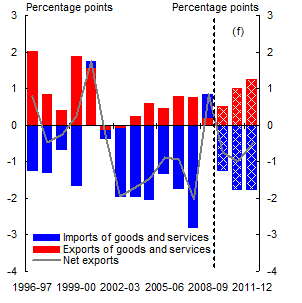
Source: ABS Catalogue Number 5206.0 and Treasury.
Non-rural commodity exports are expected to increase significantly over the forecast period, reflecting strong growth in Asia and recovering demand from the rest of the world, with additional supply capacity coming on line over the forecast period. A rebound in global steel production, underpinned by strong growth in China, is expected to result in further strength in demand for Australia's non-rural commodity exports.
As a result, non-rural commodity exports are expected to increase by 8½ per cent in 2010-11 and 8 per cent in 2011-12, higher than forecast at Budget, following more modest growth in 2009-10.
Rural exports are forecast to be more subdued than at Budget, declining by 3½ per cent in 2009-10 and by 3 per cent in 2010-11. Lower rural exports are expected to be driven in part by lower production, but also by unfavourable world wheat prices which are expected to see farmers store rather than export grain.
Chart 6: Non-rural Commodities
(Volumes)
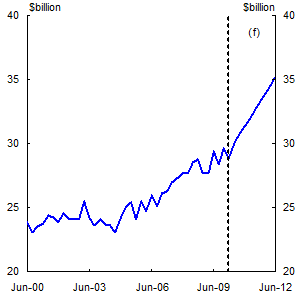
Source: ABS Catalogue Number 5302.0 and Treasury.
Continued improvement in the outlook for world growth has improved the prospects for exports of elaborately transformed manufactures (ETMs). ETM exports are expected to grow by 6 per cent in 2010-11 and 5 per cent in 2011-12, stronger than expected at Budget.
Declining numbers of foreign students studying in Australia are expected to dampen the outlook for services exports, with growth for 2010-11 now expected to be ½ of a percentage point - lower than at Budget. However, an improved world outlook and strong inbound tourism demand is expected to result in services exports returning to trend growth of 6 per cent in 2011-12, in line with Budget.
While remaining strong, the outlook for imports growth is weaker than at Budget, as a result of a decline in Australia's exchange rate and slightly weaker demand growth. Import volumes are now forecast to increase by 8½ per cent in 2010-11 and 8 per cent in 2011-12 — reflecting sizable capital import requirements as a result of strong growth in resources investment.
The terms of trade are forecast to rise by 16 per cent in 2010-11 – reaching their highest level in 60 years. This has been driven by strong rises in the prices of iron ore and coal — reflecting ongoing commodity demand from Asia. Reports suggest that metallurgical coal contract prices for the September 2010 quarter have been settled by some miners, with US dollar prices around 75 per cent above the Japanese Fiscal Year 2009-10 level and around 13 per cent higher than the June quarter 2010 quarterly contract price. Iron ore contract prices are also expected to increase in the near term. Commodity prices are expected to decline somewhat in 2011-12 as world supply of coal and iron ore increases. However, prices are still expected to remain at high levels.
Chart 7: Terms of Trade
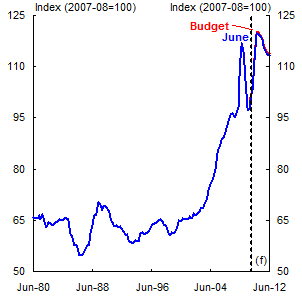
Source: ABS Catalogue Number 5206.0 and Treasury.
The trade balance is expected to be in surplus in 2010-11 by 1½ per cent of GDP, following an expected deficit of 1 per cent of GDP in 2009-10. The trade balance is forecast to move into deficit again in 2011-12 as non-rural commodity prices fall from their highs of the previous year.
The net income deficit (NID) is expected to widen significantly in 2010-11, to 4½ per cent of GDP – unchanged from Budget. This widening largely reflects the expectation of increased income outflows, in line with the stronger outlook for non-rural commodity export income.
The current account deficit (CAD) is forecast to widen to 4¾ per cent of GDP in 2009-10 – as forecast at Budget. The CAD is then expected to narrow to 3¼ per cent of GDP in 2010-11 due to higher export earnings, before widening to 4¾ per cent of GDP in 2011-12.
Chart 8: Current Account Deficit
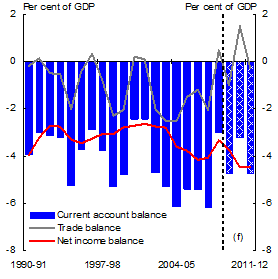
Source: ABS Catalogue Numbers 5206.0, 5302.0 and Treasury.
Employment, wages and inflation
The employment outlook for 2010-11 has been upgraded slightly since Budget, reflecting better-than-expected labour market outcomes and slower than expected real wage growth, although these factors have been partly offset by the weaker outlook for economic activity in 2010-11. The employment outlook for 2011-12 remains broadly unchanged, with employment growth steadily reducing the unemployment rate to around its full employment level by the end of the forecast period.
Employment is expected to grow by 2¾ per cent through the year to the June quarter 2010 compared with a forecast of 2½ per cent at Budget. In line with Budget, employment growth is forecast to be 2¼ per cent through the year to the June quarter 2011, and 2 per cent through the year to the June quarter 2012.
The unemployment rate forecast remains broadly unchanged since Budget, with the unemployment rate expected to fall to 4¾ per cent in late 2011-12 - in line with an expectation that the labour market will be around full capacity by the end of the forecast period.
Chart 9: Unemployment and Participation Rates (sa)
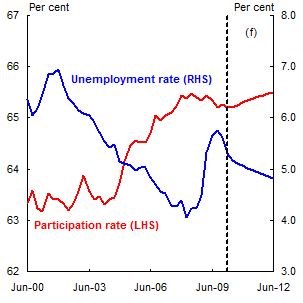
Source: ABS Catalogue Number 6202.0 and Treasury.
Average hours are recovering gradually, after almost two years of declines, but remain below their pre-downturn levels. In line with Budget forecasts, average hours are expected to recover slowly over the forecast horizon, approaching trend levels in 2011-12.
The participation rate is forecast to be slightly lower in the near term than at Budget, but is still expected to reach 65½ per cent by the end of the forecast period.
Chart 10: Employment Growth and Total Hours (sa)
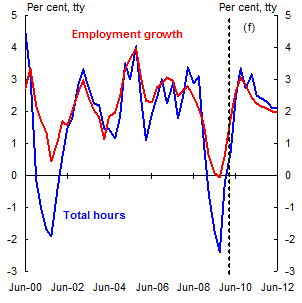
Source: ABS Catalogue Number 6202.0 and Treasury.
The outlook for wages remains broadly unchanged since Budget. Wages growth is forecast to strengthen in the near-term, although growth is expected to be moderate going forward. Compared to Budget, the 2010 Fair Work Australia minimum wage decision is expected to increase wages growth only slightly when it comes into effect in the September quarter 2010.
The ongoing tightening in the labour market is expected to support strong wages growth towards the end of 2010 and into 2011 and 2012. The Wage Price Index is forecast to grow by 3 per cent through the year to the June quarter 2010, 3&
frac34; per cent through the year to the June quarter 2011 and 4 per cent through the year to the June quarter 2012.
Since Budget, headline and underlying inflation forecasts have risen across the forecast horizon. Recent price growth has been driven by administered prices, in particular utilities, and there is evidence that these pressures may persist, notwithstanding an easing in more market-driven prices (Chart 11).
Underlying inflation is expected to be 3 per cent through the year to the June quarter 2010 and 2¾ per cent through the year to the June quarter of both 2011 and 2012.
Headline inflation is expected to pick up in the near term reflecting the continuing rebound in automotive fuel and financial services prices and a rise in the Federal excise on tobacco products. Expected large utility price increases will also impact upon inflation during 2010.
As such, headline inflation is expected to be 3¼ per cent through the year to the June quarter 2010, moderating to 2¾ per cent through the year to the June quarter of both 2011 and 2012.
Chart 11: Non-market vs market sector Inflation
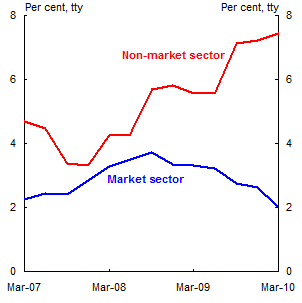
Note: Market sector excludes volatile items and deposit and loan facilities.
Source: ABS Catalogue Number 6401.0, RBA and Treasury.